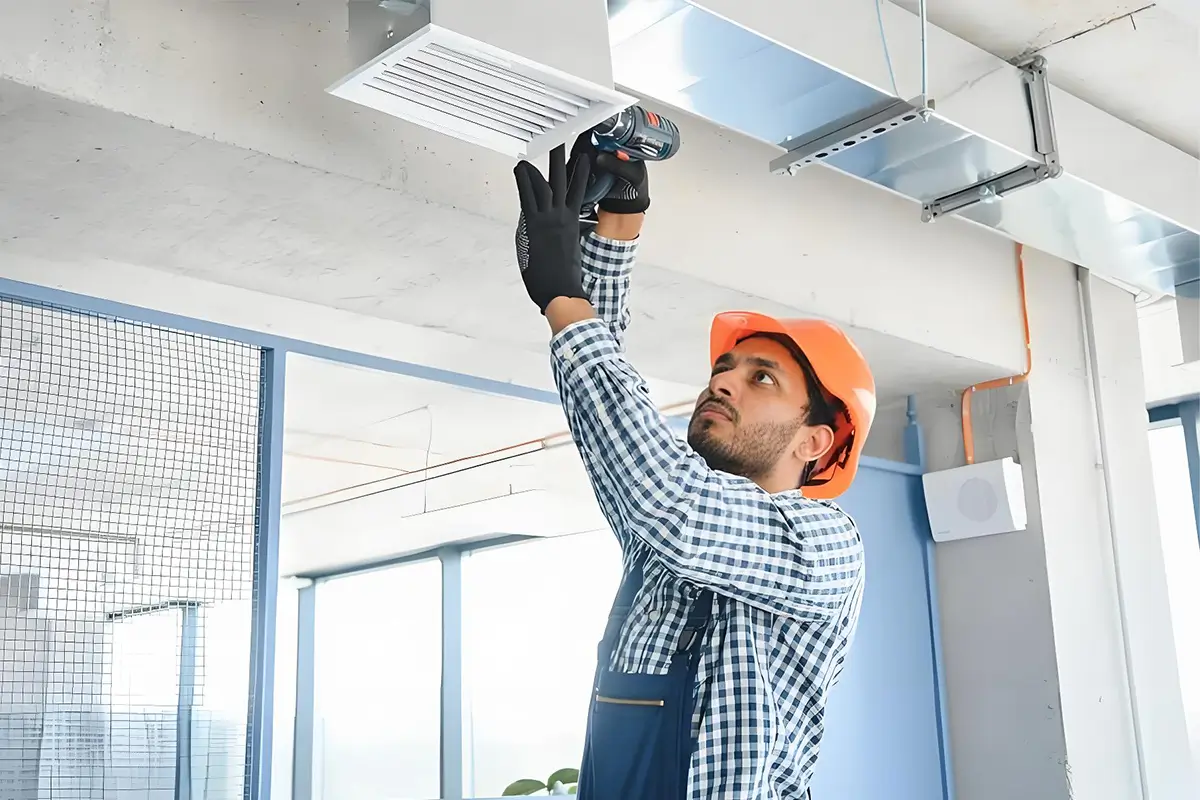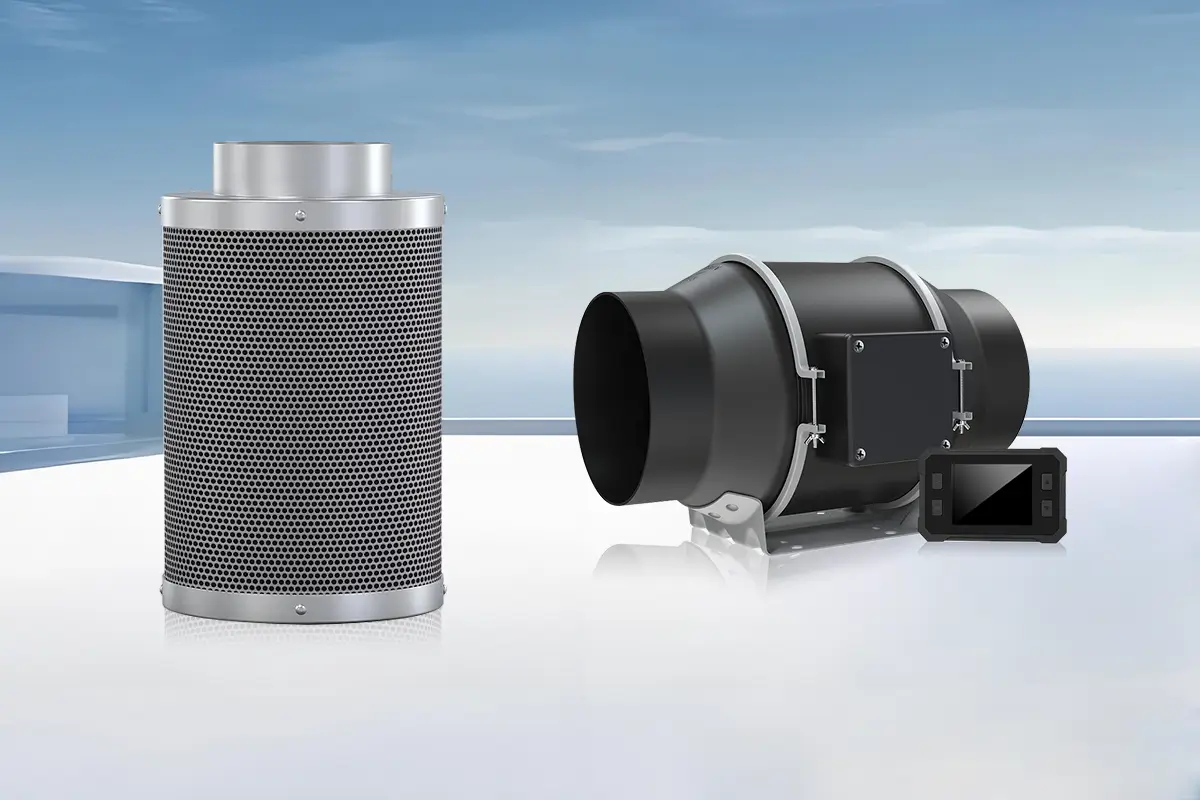
Introduction
Keeping the air fresh and free of bad smells is very important for growing plants indoors. Carbon filters and duct fans are key tools for this job. This guide will help you learn how to use a carbon filter with a duct fan. It will explain how they work, how to set them up, and how to take care of them. By the end, you will know how to make a grow space that has good air flow and controls odors.
Understanding Carbon Filters
A good carbon filter setup is essential for any grow room. It helps keep the air healthy for plants and reduces bad smells. But what makes these filters work so well? Let’s take a closer look at the main parts and ideas that make these odor-stopping tools effective.
What is a Carbon Filter?
A carbon filter is an air filter that uses activated carbon to clean the air. Activated carbon is very porous. This means it has a big surface area. It can catch many types of unwanted particles in the air. This includes bad smells and even harmful things like mold spores.
When air goes through the carbon filter, these bad elements get stuck in the pores of the activated carbon. This helps to make the air clean and fresh. This process works really well in grow rooms. In such places, plants can create unwanted odors and volatile organic compounds (VOCs).
Benefits of Using a Carbon Filter
The use of carbon filters in a grow space has many benefits. Here are some reasons why growers should consider them:
- Odor Control: This is the biggest benefit. Carbon filters can eliminate strong smells from plants at different growth stages. This keeps your grow room private and the air more pleasant.
- Air Purification: Besides controlling odors, they also filter out harmful particles such as mold, spores, and bacteria. This provides a healthier environment for both plants and people.
- Improved Plant Health: Cleaner air from carbon filters helps plants grow better and stronger in your grow room.
Choosing the Right Duct Fan
Carbon filters are great at catching unwanted particles. However, they need a good way to pull air through. This is where duct fans, also known as inline or exhaust fans, are helpful.
Types of Duct Fans

There are two main types of duct fans that work well with carbon filters: axial fans and centrifugal fans. Axial fans, called propeller fans, have a simple design. They move air in a straight line and are good for general ventilation. Centrifugal fans are different. They are stronger and more efficient. These fans take in air from the center and push it out to the side, which creates a stronger airflow.
Key Specifications to Consider
When choosing a duct fan for your carbon filter setup in a grow tent, several factors come into play. Determining the appropriate size for your grow tent or room is paramount. Consider the cubic footage of your space and choose a fan with an airflow capacity that can effectively ventilate the entire area. Here’s a quick reference:
|
Grow Tent Size |
Recommended Duct Fan CFM |
|
2′ x 2′ |
40-70 CFM |
|
4′ x 4′ |
150-200 CFM |
|
5′ x 5′ |
250-350 CFM |
Installation Process
Installing a carbon filter in your duct fan is important for keeping the air clean in your grow room. Start by setting up the carbon filter and linking it to the ducting. Use an exhaust fan to push out the filtered air. This helps to remove odor and mold. Make sure to check the airflow to find the best way to bring in fresh air in your grow tent. This process is key to making your grow space work better.
Preparation Steps
Before you start the installation, you should collect all the materials you need and plan your setup. Make sure you have your carbon filter, duct fan, ducting, and clamps or tape to secure the connections. Check the best spot in your grow tent or space for the setup. Remember to think about airflow and how easy it will be to access.
Step-by-Step Installation Guide
- Connect the Duct Fan: Use clamps or tape to attach the duct fan to the carbon filter. Make sure the seal is airtight. The fan should pull air through the filter, so keep airflow direction in mind.
- Hang the Assembly: Hang the carbon filter and duct fan assembly inside your grow tent. Place it close to your plants to capture odors effectively.
- Connect Ducting: Attach ducting to the other end of the duct fan. Connect it to your exhaust point and secure it with clamps or tape, if needed.
- Seal Connections: Check all connections closely to make sure they are airtight. If there are leaks, it can hurt the system’s efficiency.
- Plug in and Test: Once everything is secure, plug in the duct fan to a power source and turn it on. Check for good airflow and listen for strange noises.
Operating the System
After you install your carbon filter and inline fan system, you need to make some adjustments. This will help you keep the best atmosphere in your grow space.
Adjusting Fan Speed
Finding the best fan speed means keeping a good balance between controlling odors and keeping a comfortable temperature and humidity in your grow tent. Start with a slow speed and slowly raise it while you watch the conditions inside. It’s better to not run the exhaust fan all the time. Using a timer to set when it works can help save energy and still allow for good ventilation.
Monitoring Airflow and Performance
Regularly check your system’s airflow and performance. It is important to spot any problems early. Look for signs of low airflow, strange noises from the fan, or unusual smells. These could mean you need to replace the filter or adjust your setup.
Maintenance Tips
To keep your carbon filter and duct fan system running at its best, you need to add some maintenance steps to your regular routine.
1. Regular Checks and Replacements
One important part of maintenance is checking the carbon filter often. As time goes by, the activated carbon in the filter fills up with trapped particles and stops working well. The time a filter lasts can change based on how much you use it and other outside factors. But, it is usually suggested to change carbon filters every 12 to 18 months.
2. Cleaning Procedures
Cleaning your duct fan often can keep the airflow working well. First, turn off and unplug the fan. Then, take it apart following the steps from the manufacturer. Carefully clean any dust or debris from the fan blades and its housing. Do not use water or cleaning solutions on the carbon filter. This can harm the activated carbon.
Conclusion
In conclusion, using a carbon filter in your duct fan is very important for keeping the indoor air clean and fresh. When you know the benefits of a carbon filter and follow the right steps for installing and caring for it, your duct fan system will work well. You should check, replace, and clean the filter regularly. This helps it last longer and keeps the airflow strong. Picking the right duct fan and carbon filter is key for getting the best results. If you want more details on how to use carbon filters in duct fans, check our additional resources section for expert help.
Additional Resources
For growers who want more information on grow tent setup, ventilation systems, and improving grow room environments, there are many resources online. Good gardening websites, forums, and blogs by manufacturers offer helpful tips and details to support your growing journey.
Whether you have been growing for a long time or are just starting, learning more is always a good idea. With the right information and tools, you can build a successful indoor garden. This will help reduce odors and create a healthy and productive grow space.
Frequently Asked Questions
What are the benefits of using a carbon filter in a duct fan
Using a carbon filter in a duct fan helps get rid of odors, allergens, and pollutants in the air by filtering them at the intake. This improves the air quality inside your home. It can also lower health risks and make your living space feel fresher.
How often should I replace the carbon filter in my duct fan
It is a good idea to change the carbon filter in your duct fan every 6 to 12 months. This depends on how much you use it and the air quality. Changing it regularly helps keep good air flow and clean air inside. Always follow the manufacturer’s instructions for the best results.
Can I use a carbon filter in a duct fan for both odor reduction and air purification
Certainly!
What are the common issues when installing a carbon filter in a duct fan
Common problems when setting up a carbon filter in a duct fan are bad fitting, which can cause air leaks. You might also have trouble reaching the filter for changes or maintenance. Another issue can be if the filter does not match the fan size. Using the right installation methods can help solve these problems.
How do I properly maintain a carbon filter in a duct fan
- Check your carbon filter often for dirt buildup.
- Clean or replace it based on the manufacturer’s instructions.
- Vacuuming or washing the filter helps it work better at trapping particles and odors.
- Taking care of your filter makes sure your duct fan works its best.
